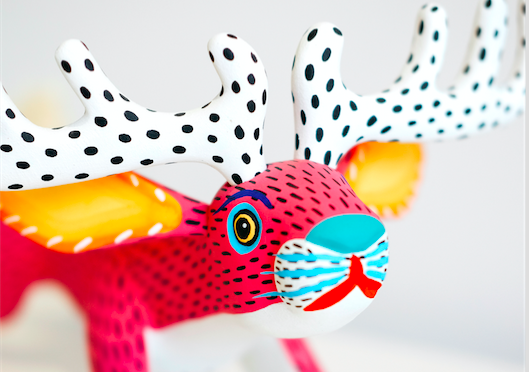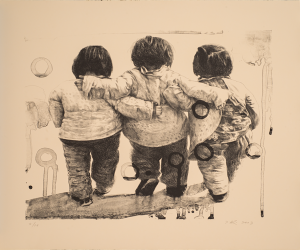Boutiques parade up Wisconsin Avenue. Slick acrylic furniture and uninteresting floor-lamps grow up into the windows with looming price tags—reminders of empty wallets. In the window of the Phoenix, one such boutique, wooden carvings from Mexican artist Luis Pablo welcome guests inside where the artist himself is calmly at work.
You can feel the pull of the open door as they pass. Inside, silver jewelry lies in grid formations on open tables and hangs in glass cases. Prowling between the fineries are little disfigured wooden creatures, illuminated by their bright and garish colors. Their mouths are snarling, teeth exposed beneath wild, blossoming eyes.
These little creatures are the handiwork of Luis Pablo, a native of the state of Oaxaca who has sold his work to The Phoenix for years. After a failed attempt to bring him to Washington in 2001, he has finally arrived for a reception and a carving demonstration in the store’s back garden.
Samantha Hays Gushner, whose family owns the Phoenix, leads me out back. Gushner and her parents have enjoyed a long relationship with Mexico, and particularly Oaxaca, traveling there almost annually in search of art and experiences to share in their storefront in Georgetown.
We enter a small porch behind the building. Mr. Pablo sits perched behind a work-bench, delicately adorning the wings of a turkey-vulture with little, black brushstrokes.
I ask Mr. Pablo about his beginnings, and he begins to explain in slow deliberate trickles of Mexican Spanish.
He tells me he started his art career from necessity— he was unemployed. “I used sell cellphones, dress nice, and keep my hands clean, and then one day I was out of a job … so I went to see a relative who works in a workshop and spoke with his boss about work. He said they were full but afterward my cousin asked me, why don’t you just start carving yourself?”
Pablo’s career then began when he cut a few limbs from a copal tree which was gifted to him by a neighbor.
“Copal wood is soft, good for carving,” Pablo said.
He formed his first works with his father’s machete and a knife that he’d had as a boy, teaching himself as he went.
According to Pablo, Oaxaca underwent a tourism boom throughout the early nineties, American travelers were buying Oaxacan wood carvings in absurd amounts.
“You could pick up a branch from the ground, strip its bark, add some paint and eyes, and sell it. A lot of people bought whatever there was because it was something new,” Pablo jokes.
Pablo claims he didn’t make art at that time for anything other than money. He questioned his customers’ motives but enjoyed the steady income.
“At that point I used to wonder, why do the Americans want this art? Why do they pay these prices for something made from wood? At first, I thought they were hollowing them out, and putting marijuana or cocaine in them for sale in the US,” Pablo said.
Now, Pablo says, his philosophies are matured, and his understanding of foreigners’ appreciation for this art has factored into his own business practices. “I own a small workshop. I’m not interested in building any sort of factory, because then you lose the goal of the work. So all I do is make special things, unique things, one at a time with something new each time,” he said. “People value the work because it’s made by hand, not by a machine.”
Part of his development, Pablo admits, stems from Gushner and her parents. Their relationship started out from a single business transaction. However, this purchase grew into a seasoned relationship as the DC-based clients continued to purchase his works, bringing them to the window-fronts of Georgetown.
As such D.C.’s relationship with Mexico earned another small fold, the interaction and friendship of two family businesses. Pablo’s visit exhibits more than just his work, and displays a small but lengthy cross-border relationship, knitting two cultures a little bit closer so art from its southern neighbor can illuminate a small corner of America’s capital.
Of course, this illumination is precisely Mr. Pablo’s aim, and he claims a simple purpose for all of his works.
“I paint a little candle on all of my pieces, like a signature. In the old days people used to put candles on the table, or somewhere high so that they would illuminate the room. That’s exactly how I want them to utilize the art.





